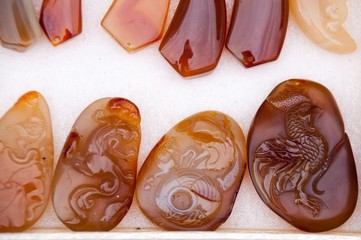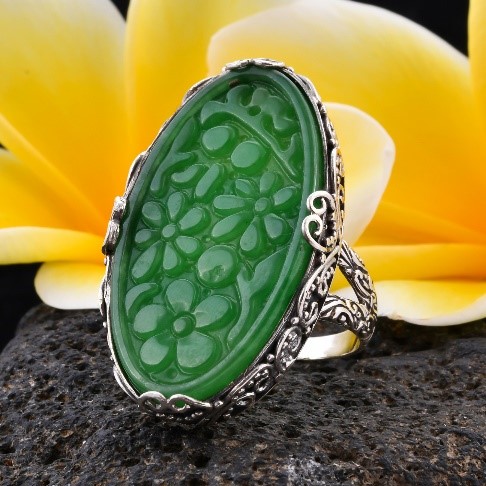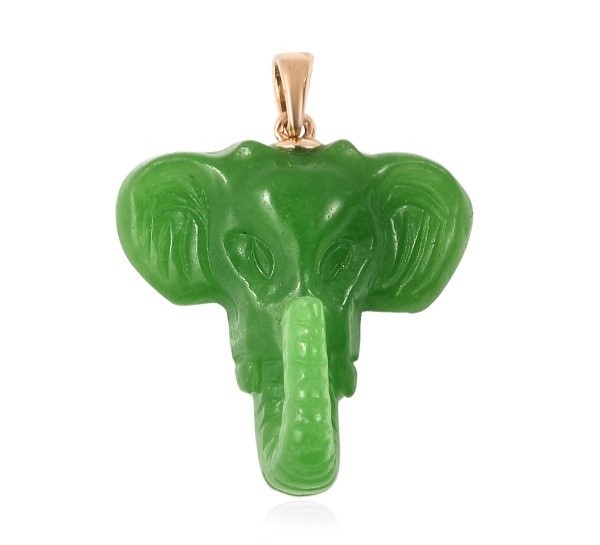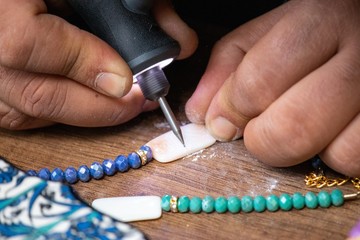Carved Gemstones
Category: Techniques | Date: 10/02/2020

Carving is an ancient art form. With skilled techniques, the carving adds a sculptural look to the gem. Carved gems add an exquisite dimension to the jewelry collections. Carving transforms rock into timeless beauty. It adds meaning to the cabochon with an engraved figure, pattern or motifs. It is an artistic blend of artistry and creativity.
Historical Significance

Gemstone carving has a rich history of the millennium. The Egyptians etched animal motifs with turquoise for amulets. The skilled artisans carved the gemstones even before the faceting techniques. The carving was used in the jewelry during the Art Nouveau movement. The geometric and natural figures inspired the jewelry used.
Ancient Sumerians, Americans, Greeks, Romans and Egyptians used jade and carnelian for carving. The British Museum exhibits an Egyptian carved ring. It highlights a cat carved on the carnelian. Carved jewelry from China showcases floral motifs on jade. Still popular, the carved gemstones with flowers are a perfect pick for the jewelry.

Themes
The carved gems are attached to the symbolic factors with a divine origin. The elements can be geometric or floral patterns. All are the combination of strength and delicacy. The designs can also imitate the medleys of spiritual themes. The motifs include dolphins, elephants, magnificent sea creatures and figurines of horses. Every motif has its own meaning.
The current situation does not focus merely on motifs or heraldic styles. It can be abstract forms mirroring in various gemstones.
Key Elements
Mohs Scale of Hardness rating – Hardness is the basic factor to find out. The lower the hardness, the softer the stone, resulting in the smooth carving. The gems used are – agate, chalcedony, quartz, amethyst, onyx, sard, heliotrope carnelian, jasper and jade.
Quality – Pieces of jewelry are the heirloom wealth for the family. The quality plays a significant role. The gemstones with inclusions are less in demand. Those which are susceptible to cracks and chips are also avoided.
Process of Carving
Carving adds a design element to the gem that adds a new visual delight. Below are some of the steps for carving a gemstone.

- Lapidary marks the stone with a design to be imprinted.
- The design is then mounted on the gem by the stick.
- After the basic shape, the diamond dresser tool imprints the design
- With a sharp right angle, the tool creates artistic elements over the surface.
- It requires extra care, as the stone can chip or split.
- Lastly, the carved rough gemstone is finely polished on all the cut edges. At times some surfaces are left unpolished to create a distinct allure.
Caring of Carved Gemstone
Below are some steps to prevent the gemstone from getting damaged:
- If stored safely, the carved gem will look clean and sparkling
- Store it in the well mounted box
- The occasional dusting with a make up brush will avoid the dust on the gem.
- To clean the dust if settled in the carved areas, soak in the lukewarm soapy water. Clean the surface gently with the soft brush. Then rinse with clear tap water. Wipe it dry with the soft cloth or let it air dry.
- Apply beeswax on the surface to maintain the lustrous finish and softness.
- Hard bumps or accidental knocks can break the stone, so handle with care.
General Facts

- Carvings result in 40% to 60% wastage of gemstones during the process.
- The most popular carved gems are emerald and ruby. It is then followed by blue sapphire. The emerald has a rating of above seven on the Mohs hardness scale,
- Designer loves softer materials like amethyst, tourmaline, or rock crystal. These gemstones are the best pick for them to experiment with extensive motifs.
Carving is a creative art with endless options. Skilled artisans can represent any image or script into a gemstone. Every unique piece has its own healing properties.